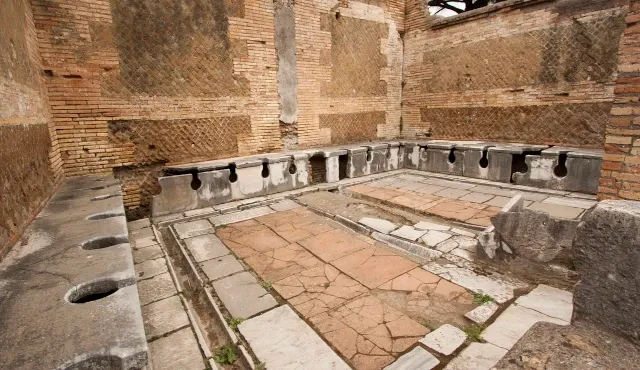How did the division of toilets by gender come about? A brief history from ancient times to today.
The division of toilets into male and female is a phenomenon that has evolved with social, cultural, and economic changes over the centuries. This practice, rooted in various societies, stems from different ideologies and needs that have changed over time. As societies developed and perceptions of privacy and the role of women in public spaces changed, the segregation of toilets by gender began to be introduced.

Antiquity and the beginnings of segregation
In antiquity, the approach to public toilets and the issue of gender segregation was significantly different from today's norms. In cultures such as ancient Rome or Greece, public toilets were often shared by both genders and served social functions beyond their basic functionality.
In ancient Rome, public toilets, known as latrines, were often large, communal rooms without partitions between individual places. These toilets not only served for physiological needs, but also served as meeting places, discussions, and information exchanges. In such spaces, there was no division based on gender, which indicates a significantly different approach to privacy and publicity compared to modern standards.
Similarly in ancient Greece, public toilets were often accessible to both genders. Although information on this topic is more limited than in the case of Rome, it is known that Greek toilets, known as aphedrones, were part of larger public complexes, such as gyms or palaestras, where both genders could use the same spaces.
This historical perspective emphasizes how variable social and cultural norms are, and how infrastructure and architecture reflect these changing values and beliefs. Antiquity shows us that the division of toilets by gender is not a universal or immutable norm, but a result of specific historical and cultural contexts.
Development of segregation in Europe
The development of segregation into male and female toilets in Europe has its roots in broader social and cultural changes that occurred during the Middle Ages and lasted until modern times. This process was closely related to evolving norms regarding privacy, decency, and the role of women in public spaces.
In the Middle Ages, toilets in Europe were usually simple and not specifically adapted to the needs of one gender. However, over time, especially during the Renaissance and Enlightenment periods, changes in attitudes towards privacy and hygiene began to emerge. This was influenced by both the growing importance of individuality and changing patterns of social life.
The breakthrough moment was the 19th century, when the industrial revolution and urbanization took place. Women began to participate more and more in public life, working in factories and offices. This led to the need to provide them with proper sanitary conditions in the workplace. In this context, separate toilets for women began to be seen as a means of protecting their privacy and decency, as well as a way to ensure safety in the workplace. In the United States, the first law requiring separate toilets for men and women was introduced in Massachusetts in 1887.
As a result, at the end of the 19th and beginning of the 20th century, gender segregation in toilets became increasingly common throughout Europe and North America. Building laws and regulations began to formalize and standardize separate toilets for both genders, reflecting changing social and cultural norms.
Impact on modern society
Today, the division of toilets into male and female is deeply rooted in culture and society, but it has become a controversial topic in discussions about the rights of transgender and non-binary individuals. Many argue that the traditional division of toilets is outdated and does not consider the needs of all members of society. This debate highlights how physical space is connected to larger social issues such as gender equality, privacy, and acceptance of diversity.
This information is based on historical and social research conducted by experts in this field, such as Terry Kogan, a law professor at the University of Utah, whose work focuses on the history of gender segregation in public toilets. More information on this topic can be found in articles published by History News Network and The World from PRX.









